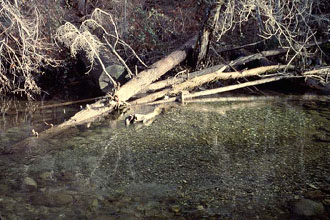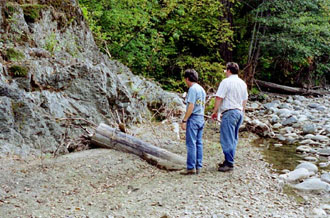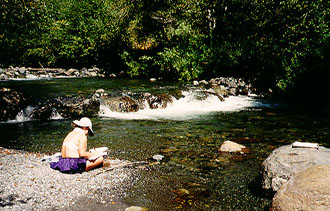Bibliography Background About KRIS
Instream Structures
Fisheries scientists in the 1980s began to recognize that stream habitat had been simplified by past land use activities (Hassler, 1984). Northwestern California streams, particularly those that had intensively logged watersheds, were dominated by riffles with low pool frequency and little habitat complexity (Kier Associates, 1991; Pacific Watershed Associates, 1994). Throughout the 1980s and 1990s, millions of dollars of state and federal money were spent to increase habitat complexity through direct manipulation of streams. Gabions, inexpensive wire baskets filled with rocks, were used in initial efforts but were found to have a very short life. Boulders and log structures were then used extensively throughout northwestern California to accelerate recovery of fish habitat. Stream conditions were analyzed through habitat typing surveys, which led to recommendations to use instream structures to improve habitat diversity.
Olsen (1997) showed that juvenile salmonid rearing densities increased around instream structures in Klamath National Forest streams. He showed that large wood and rock structures added habitat diversity and that coho and chinook salmon juveniles were found during post-project surveys while only steelhead were present before (POPUP resteval2.gif). Unfortunately, over 50% of the fish habitat improvement structures were destroyed as a result of high flows and sediment transport during the January 1, 1997 storm event (de la Fuente, 1998). Kier Associates (1999) found that the instream structure failure rate was lower in Six Rivers National Forest where watershed conditions were less disturbed.
 |
 |
|---|---|
| Large wood structures, such as this one in Elk Creek, Klamath National Forest, were extensively used by juvenile salmonids. Photo courtesy of Alan Olsen, KNF. | Shifting bedload in Elk Creek during the January,1997 storm destroyed many instream structures. The Elk Creek watershed was extensively salvage-logged after the 1987 fire and road densities in the watershed became very high. |
 |
 |
|---|---|
| This large wood structure in Red Cap Creek in Six Rivers National Forest remained functional after the 1997 storm. No logging has taken place in the Red Cap Creek watershed for the last decade, and road densities are not high. | These two boulder weirs withstood the 1997 storm. Bluff Creek, within the Six Rivers National Forest, has been allowed a period of rest and no new roads have been built during the last decade. Photos courtesy of Six Rivers N.F |
Fish Creek, a tributary of the Clackamas River in Oregon, had hundreds of instream structures installed in the 1980s to help improve fish habitat complexity. In February 1996 storm event, almost all the structures were lost, seventeen miles of stream channel were scoured and 237 landslides occurred, many triggered by road failures (Hickman, 1999). In response, the U.S. Forest Service has gone to a primarily upland erosion control strategy for fish restoration in this basin and 341 road crossings removed and 105 miles of road obliterated.
Similar high failure rates of instream structures have also been noted in other areas of the Pacific Northwest. Nawa and Frissell (1992) found that 60% of instream structures surveyed in southwest Oregon and southwest Washington were either damaged or destroyed by 2-10 year storm events. They concluded that "commonly prescribed structural modifications often are inappropriate and counterproductive in streams with high or elevated sediment loads, high peak flows or highly erodible bank materials." Frissell and Nawa (1992) concluded that use of in-stream structures would not work until watershed health had improved. With regard to southwest Oregon they found that: "Basins continue to suffer impacts from failing roads, high erosion rates along streams in second growth forests, continued logging on steep, highly erodible federal lands and repeated, short-rotation logging on private lands where there is little regulatory protection for unstable slopes and headwater stream channels."
The California Department of Fish and Game inventoried in-stream structures in 53 creeks and gathered statistics on 1423 structures throughout northern California (Hopelain, 1995). The purpose of the inventory was to partially assess the success of CDFG in-stream restoration activities. According to the study, in-stream restoration investments between 1980 and 1995 totaled over $45 million. The study began in 1993 with a random sampling of 25% of the structures in the 53 streams selected. Some new streams, and a sub-set of previously visited sites were surveyed in 1995, after higher flows had occurred. Overall success rate scores for structures throughout northwestern California were higher in 1993 than in 1995 (see chart of results). No significant storm events occurred between 1986 and 1994, while January and March 1995 saw two large storms. This study should provide useful information on channel conditions for north coast watershed assessment. Success and failure of restoration projects can be analyzed with respect to watershed disturbance, sediment yield, road densities and other factors.
References
De la Fuente, J. 1998. Effects of the 1997 Floods on the Klamath National Forest. Klamath National Forest, Supervisors Office, Yreka, CA.
Frissell, C. and R. Nawa. 1992. Incidence and Causes of Physical Failure of Artificial Habitat Structures in Streams of Western Oregon and Washington. North American Journal of Fisheries Management 12:182-197.
Hassler, T.J. (Ed.), 1984, Pacific Northwest stream habitat management workshop. Proceedings published by the California Cooperative Fisheries Unit, Humboldt State University, Arcata, CA, 329 p.
Hickman, T.L. 1999 . Fish Creek -- Adaptive Watershed Management in the 21 st Century: A Case Study. U.S. Department of Agriculture, Forest Service. Pacific Northwest Research Station. Mt. Hood National Forest. Estacada, Oregon. 12 pp.
Hopelain, J. 1995 . Draft Evaluation of Salmonid Habitat Restoration Structures in Northwestern California Streams Conducted During 1993 and 1995. CDFG Inland Fisheries, Sacramento, CA. Draft dated 2/17/98. 30 p.
Kier Associates. 1991 . Long Range Plan for the Klamath River Basin Conservation Area Fishery Restoration Program. Klamath River Basin Fisheries Task Force and USFWS, Yreka, CA.
Kier Associates. 1999 . Mid-term Evaluation off the Klamath River Basin Fisheries Restoration Program. Prepared for The Klamath River Basin Fisheries Task Force and USFWS, Yreka, CA. Kier Assoc., Sausalito, CA. 303 pp.
Olson, A.D. and J.R. West. 1989. Evaluation of Instream Fish Habitat Restoration Structures in Klamath River Tributaries, 1988/1989. Annual Report for Interagency Agreement 14-16-0001-89508. US Forest Service. Pacific Southwest Region. Klamath National Forest. Yreka, CA. 36pp.
Pacific Watershed Associates. 1994 . Action plan for the restoration of the South Fork Trinity River watershed and its fisheries. Prepared for U.S. Bureau of Reclamation and the Trinity River Task Force, Contract No. 2-CS-20-01100. February 1994.
